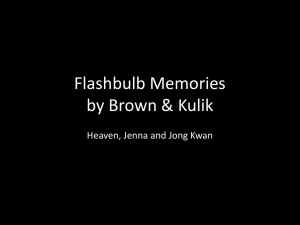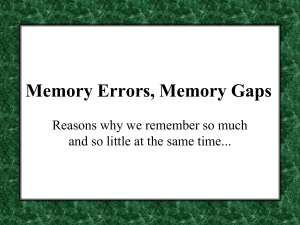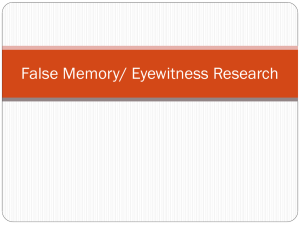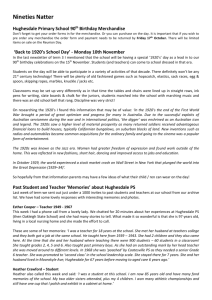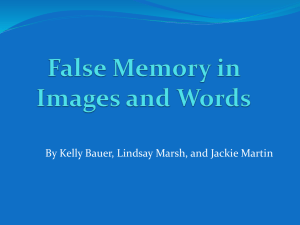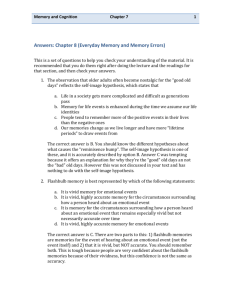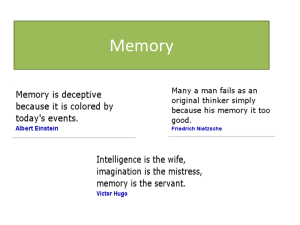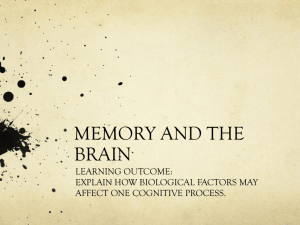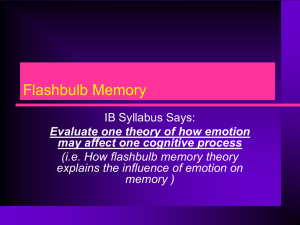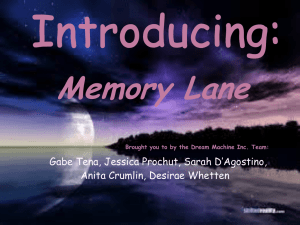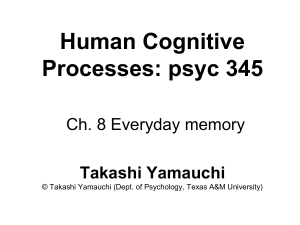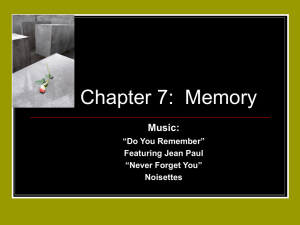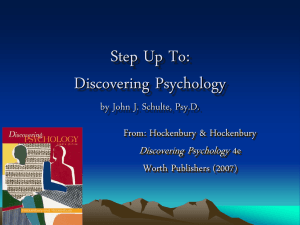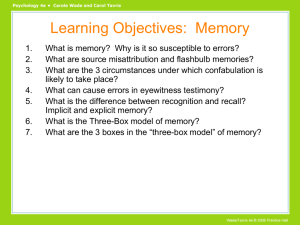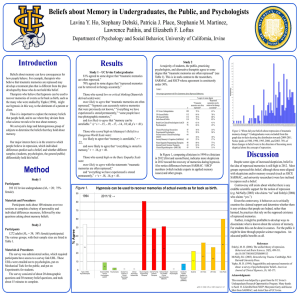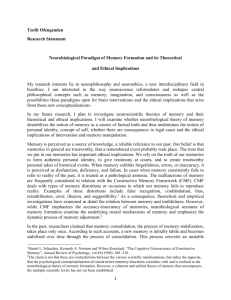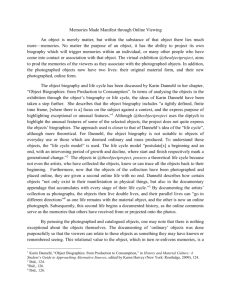Memory Bartlett`s war of the ghosts Conclusion: we recall
advertisement
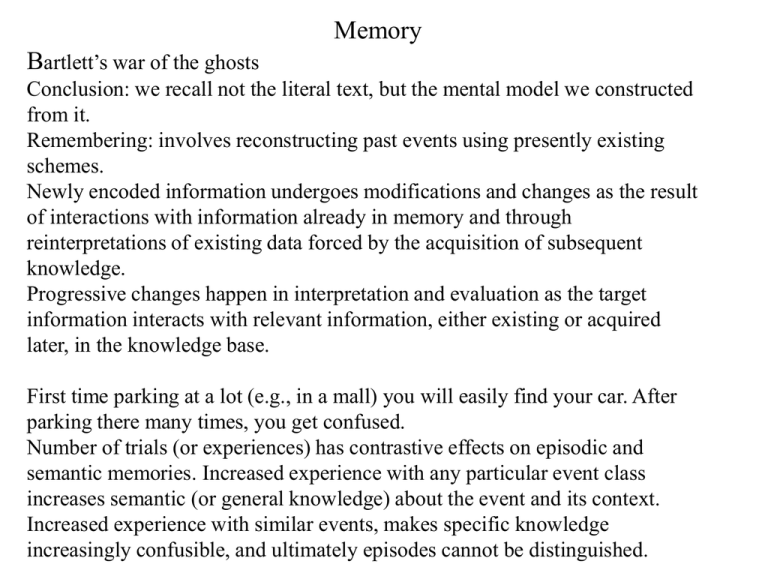
Memory Bartlett’s war of the ghosts Conclusion: we recall not the literal text, but the mental model we constructed from it. Remembering: involves reconstructing past events using presently existing schemes. Newly encoded information undergoes modifications and changes as the result of interactions with information already in memory and through reinterpretations of existing data forced by the acquisition of subsequent knowledge. Progressive changes happen in interpretation and evaluation as the target information interacts with relevant information, either existing or acquired later, in the knowledge base. First time parking at a lot (e.g., in a mall) you will easily find your car. After parking there many times, you get confused. Number of trials (or experiences) has contrastive effects on episodic and semantic memories. Increased experience with any particular event class increases semantic (or general knowledge) about the event and its context. Increased experience with similar events, makes specific knowledge increasingly confusible, and ultimately episodes cannot be distinguished. Loftus & Palmer (1974) How accurately do we remember the details of a complex event, like a traffic accident, that has happened in our presence? How well do we do when asked to estimate some numerical quantity such as how long the accident took, how fast the cars were moving, or how much time elapsed between the sounding of a horn and the moment of collision? Tendency to overestimate the duration of complex events; Marshal (1969): air force personnel knowing they would be questioned on the speed of a car estimated it from 10 to 50 mph- the car was going only 12 mph. Study 1: shown films of traffic accidents, then questions about them “About how fast were the cars going when they hit/smashed/bumped/collided/contacted each other? Smashed: 40.8 (mean speed estimate), collided: 39.3, bumped: 38.1, hit: 34,contacted: 31.8 Study 2: 150 students shown film of multiple car accident (less than 1 min) followed by questions. One question asked about the speed of the cars. 50 were asked “About how fast were the cars going when they smashed and 50 when they hit each other. 50 not asked about speed. 1 week later, answered new questions. Critical one: Did you see any broken glass? Smashed: 16 yes, 34 no; Hit: 7 yes, 43 no; control: 6 yes, 44 no. “Two kinds of information go into one’s memory for some complex occurrence. The first is information gleaned during the perception of the original event, the second is external information supplied after the fact. Over time, information from those two sources may be integrated in such a way that we are unable to tell from which source some specific recalled. All we have is one memory.” Flashbulb Memories (Neisser 1982) Impressive consistency to the organization of such memories: •Place •Ongoing activity •Informant •Aftermath •One’s own affect and that of others At first glance, FB memories appear to be obvious illustrations of a commonsense principle: people remember what is important Problem: Actual content of FB memories does not meet that criterion “The fact of JFK’s death may be important but what difference does it make who told me about it, or where I was when I heard the news?” Why do we remember such things? Brown and Kulik: ‘Now Print’ mechanism in the brain that triggers whenever we believe that an important (consequential) event takes place. Supposedly, this mechanism ‘prints’ the whole event into a permanent record for later. This hypothesis implies: A) FB memories are accurate B) The process by which FB memory is created occurs at the time of the event C) Surprise, emotionality, and similar reactions are closely related to the consequentiality of the event, and that higher levels of surprise and emotionality lead to good memory D) Common characteristics among different FB memories reflect the common characteristics of an underlying neural mechanism All these implications deserve careful scrutiny Accuracy of FB memories Vivid recollection and accurate testimony may be wrong Neisser: “For many years I have remembered how I heard the news of the Japanese attack on Pearl Harbor, which occurred on the day before my thirteenth birthday. I recall sitting in the living room of our house- we only lived in that house for one year, but I remember it well- listening to a baseball game on the radio. The game was interrupted by an announcement of the attack, and I rushed upstairs to tell my mother. This memory has been so clear for so long that I never confronted its inherent absurdity until last year: no one broadcasts baseball games in December! (It can’t have been a football game either: professional football barely existed in 1941, and the college season ended by Thanksgiving). FB memories can be as wrong as other kinds of memory; they are not produced by a special quasi-photographic mechanism. When are FB memories established Memories become FB primarily through the significance that is attached to them afterwards. Endurance, not immediate survival is the question. We can all give good accounts of what happened earlier today. FB moments are sure to be pondered, discussed, and redescribed on subsequent occasions. Hypothesis: persistence is due to the frequent- rehearsals- reconsideration they receive. Emotionality Emotional experiences are not especially well remembered High levels of arousal narrow the focus of attention; they unlikely promote detailed recall of circumstances. Structure of the Memories Resemble narrative conventions In our culture we all know how to tell a story (who, what, when, where, and why) “The flashbulb recalls an occasion when two narratives that we ordinarily keep separate – the course of history and the course of our own life- were momentarily put into alignment. We remember the details of a flashbulb because those details are the links between our own histories and History. Frequent rehearsal and discussion contribute to the accuracy. The term flashbulb is misleading; these are not momentary snapshots as enduring benchmarks.
